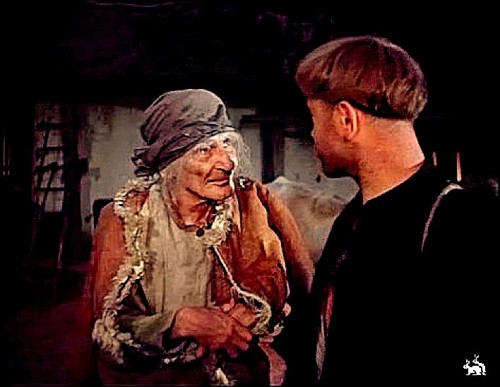Part of Vintage Viewing, exploring the work of female filmmaking pioneers.
Who gets the credit for a collaborative art-form? When the makers are a husband and wife team, the answer seems to be the husband. We are only now beginning to give credit to Marcia Lucas for her major creative input into the original Star Wars, as both Oscar-winning editor and source of feedback and ideas. A similar fate has met Elizaveta Svilova. Though Sergei Eisenstein is the best-known theorist of film montage, the most striking Soviet documentaries of the 1920s to use kinetic and dialectic montages were made by Kinoglaz (Cinema-Eye), who issued their manifesto in the name of a ‘Council of Three’ – futurist poet and agit-prop director Dziga Vertov, Vertov’s brother and cinematographer Mikhail Kaufman, and Vertov’s wife and editor, Elizaveta Svilova. In June 1923’s LEF magazine, the Council of Three, published “Kinoks: A Revolution” which was a call to arms for cinema verite that could record real life “caught unawares,” while lambasting the falsity and backwardness of fiction film. This manifesto is usually studied by students of Vertov’s art, but what of the woman who was one third of the Council of Three? Who was Elizaveta Svilova?
Born Elizaveta Schnitt in 1900, she became an editing assistant for Pathe in Moscow at the age of just 14. By 1918, she was editing feature films at Goskino, the Soviet state cinema, and from 1922 to 1924 she was their chief editor. Thrilled by Vertov’s dynamic early documentary reels with the agit-propaganda trains, she would be his most vigorous champion toward mainstream support and feature documentaries. In 1922 she joined the Kinoglaz group, serving as chief editor and later assistant director on Vertov’s films.
Dziga Vertov and Elizaveta Svilova were married in 1924, the year they produced the film Kino Eye: Life Caught Unawares. In 1927, Dziga Vertov fell out of favor of the regime and was fired from Sovkino studio (the Soviet cinema studio), with his avant garde and Futurist ideas clashing with the new style of Socialist Realism and the demands of Soviet propaganda. VUFKU, the All-Ukrainian Photo-Film Directorate, which was staffed at the time by administrators sympathetic to Ukrainian Futurism, hired Vertov and Man With A Movie Camera was the sensational result, screened in Germany, France, England, and the United States, and regarded as the most formally experimental film of the silent era. It was followed by an experimental “Symphony of Noises” in Vertov and Svilova’s first sound film, 1930’s Enthusiasm: Symphony of the Donbass. After releasing Three Songs About Lenin in 1934, Vertov was awarded the Order of the Red Star for his most popular film. Though physically unscathed by the Stalinist purges, Vertov’s health began to fail in the 1930s and he and Svilova struggled to find new patronage from the state-monopolized studio system. Since 1938, virtually all Vertov’s many script ideas went unproduced. He had fallen from favour.
During World War II, Vertov’s Jewish family was destroyed by the Nazis and he suffered a nervous breakdown. It would be Svilova who would edit the first film about Auschwitz in 1945. Svilova’s own skills as an editor and filmmaker saw her strike out to direct feature documentaries, including combat documentaries of the Second World War, showing a keen eye for sweeping crowd scenes and the rhythm of military action, taming the avant-garde aesthetics of Kino-Eye into something more palatable to mainstream Soviet audiences. In 1946, she was awarded a Stalin Prize for her work co-directing The Fall Of Berlin, while another film, The Atrocities of the Fascists (Zverstva Fashistov) supplied visual evidence of death camps to the Nuremberg Trials. Vertov died of stomach cancer in 1954, and Svilova retired from the industry to faithfully catalogue his manuscripts, overseeing the publication of many of his theoretical writings and cementing the recovery of his reputation. She passed on herself in 1975, and was buried in Moscow’s Novodevichy Cemetery.
Man With A Movie Camera – 1929
One of the most influential silent films ever made, Man With A Movie Camera passes in a blizzard of dynamic montage, illustrating an impressionist portrait of a day’s life in the USSR. By a trick of superimposition, the cinematographer Mikhail Kaufman sets up his camera on top of a giant camera. Clouds race over the streets in speeded time. An empty cinema awaits, the chairs magically springing open for the crowds that stream in as the film is loaded. Light ignites and the frozen orchestra springs to life. A girl sleeps, representing the sleeping city, in a film that offers us Everyman’s little used colleague, Everywoman, as an equal representative of the human race. Shots of homeless children sleeping rough suggest why this film was not universally admired by the authorities as Soviet propaganda.
From storefront dummies to machines, the city is frozen. Only the cinematographer’s car is in motion. Pigeons fly backwards, in a film that revels in the power of editing to alter, flip and juxtapose, with the camera editing a suggested collision between man and train, suggestively framing it as the sleeping woman’s nightmare. Tramps awaken and react playfully or defensively to being filmed. Rather than manipulating with invisible editing, the film systematically draws attention to the cinematic gaze’s power to manipulate. The attractive woman’s morning wash is mapped onto the washing of streets and windows, while her eyes opening is intercut with shutters snapping open, disarming voyeurism. Later, the voyeuristic impulse itself is explored as a man’s ogling eyeball is superimposed onto the camera lens when giving a close-up of a napping woman’s legs on a park bench. Women and their labour are often the focus of the film, from seamstresses to older women working as street vendors. We see the woman’s eye creating the film as frozen shots of rolls of film capturing women young and old become sped up, reviewed and spliced by Elizaveta Svilova herself, filmed at work at her editing desk. With the Geena Davis Institute on Gender in Media highlighting the fact that only 17 percent of cinematic crowds are women, Person With A Movie Camera portrays a refreshingly gender-balanced world simply by allowing women of all ages to take up half the space on screen, while highlighting the gender balance of the film’s own authorship through Svilova’s visible role as editor. Women give birth, marry, divorce, mourn, play sport and work long hours, and their dramas are the film’s, as much as that of male laborers. The film is fascinated by mechanics and industry, but not to the exclusion of humanity. Women are half the audience onscreen at the film’s end, watching and commenting on the action.
[youtube_sc url=”https://www.youtube.com/watch?v=-zeCdQJcA88″]
Enthusiasm: Symphony on the Donbass – 1930
Everywoman returns in earphones as the onscreen listener to Vertov’s symphony of noises, which applies collage and dialectic principles of montage to the accumulation of noises, in one of the first feature documentaries of the era of sound. The majestic tolling of a church bell becomes the bourgeois sound of a cuckoo clock, undermining the majesty and intimidating power of the church. The camera staggers with drinkers outside, intercut with the prayers of the faithful to associate both as opiates of the masses, before Soviets swarm the church, demolish its towers and carry away its icons as part of the “struggle against religion.” A female sculptor moulds a bust of Lenin, icon of the liberated “Soviet New Woman.” Model tractors and tools illustrate the first Five Year Plan of collectivization, industrialization and increased production (at least theoretically). The models meld into the real factories of the Donbass mines. Industrial sounds replace the orchestra, including discordant squeals and whistles. Vertov defended his use of discordant “noise” as a feature of proletarian cinema opposed to bourgeois ideas of music: “We really are domestic, and for us these sounds are ‘noise’—but for the worker in the Donbass every sound has a specific meaning; for him there are no ‘noises.'” Made before the cruelest years of collectivization, Vertov’s film is a hymn to the industrial laborers of the first Five Year Plan and to the optimism of early Stalinism. Speakers lays out the need for mass mobilization. A triumphal march plays as the workers exit the mines to cheering, low angle shots amplifying their heroism. In its experimental loopings of industrial noise, Vertov and Svilova’s film anticipates the musique concrete movement, setting up elaborate call and responses between chugging heavy machinery and squealing whistles, before the machines and laborers themselves are made to play the soundtrack’s triumphal march with their synchronized hammering. Women singing in the fields and threshing grain are given equally triumphalist framing, before a workers’ brass band plays the film out.
[youtube_sc url=”https://www.youtube.com/watch?v=vUInm2dC6Ug”]
Brigit McCone writes and directs short films and radio dramas. Her hobbies include doodling and learning new things.




















